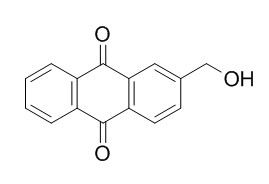2-(Hydroxymethyl)anthraquinone
2-(Hydroxymethyl)anthraquinone exhibits strong activity against Helicobacter pylori ATCC 43504 at 0.01 mg/disc.
Inquire / Order:
manager@chemfaces.com
Technical Inquiries:
service@chemfaces.com
Tel:
+86-27-84237783
Fax:
+86-27-84254680
Address:
1 Building, No. 83, CheCheng Rd., Wuhan Economic and Technological Development Zone, Wuhan, Hubei 430056, PRC
Providing storage is as stated on the product vial and the vial is kept tightly sealed, the product can be stored for up to
24 months(2-8C).
Wherever possible, you should prepare and use solutions on the same day. However, if you need to make up stock solutions in advance, we recommend that you store the solution as aliquots in tightly sealed vials at -20C. Generally, these will be useable for up to two weeks. Before use, and prior to opening the vial we recommend that you allow your product to equilibrate to room temperature for at least 1 hour.
Need more advice on solubility, usage and handling? Please email to: service@chemfaces.com
The packaging of the product may have turned upside down during transportation, resulting in the natural compounds adhering to the neck or cap of the vial. take the vial out of its packaging and gently shake to let the compounds fall to the bottom of the vial. for liquid products, centrifuge at 200-500 RPM to gather the liquid at the bottom of the vial. try to avoid loss or contamination during handling.
Molecules.2019, 24(4):E744
Biomimetics (Basel).2022, 7(4):154.
Front Microbiol.2022, 12:833233.
iScience.2023, 26(9):107602.
SRM Institute of Sci&Tech2022, 34(1): 32-37
Biomolecules.2024, 14(5):589.
OENO One2023, 57:3.
J Neuroinflammation.2020, 17(1):75.
J Ethnopharmacol.2024, 333:118415.
LWT2021, 138:110630.
Related and Featured Products
J Ethnopharmacol. 2006 Apr 21;105(1-2):255-62.
Antibacterial activity of Tabebuia impetiginosa Martius ex DC (Taheebo) against Helicobacter pylori[Pubmed:
16359837]
METHODS AND RESULTS:
The growth-inhibiting activity of Tabebuia impetiginosa Martius ex DC dried inner bark-derived constituents against Helicobacter pylori ATCC 43504 was examined using paper disc diffusion and minimum inhibitory concentration (MIC) bioassays. The activity of the isolated compounds was compared to that of the commercially available anti-Helicobacter pylori agents, amoxicillin, metronidazole, and tetracycline. The biologically active components of Tabebuia impetiginosa dried inner bark (taheebo) were characterized by spectroscopic analysis as 2-(Hydroxymethyl)anthraquinone, anthraquinone-2-carboxylic acid, and 2-hydroxy-3-(3-methyl-2-butenyl)-1,4-naphthoquinone (lapachol). With the paper disc diffusion assay 2-(Hydroxymethyl)anthraquinone exhibited strong activity against Helicobacter pylori ATCC 43504 at 0.01 mg/disc. Anthraquinone-2-carboxylic acid, lapachol and metronidazole were less effective, exhibiting moderate anti-Helicobacter pylori activity at 0.1 mg/disc. Amoxicillin and tetracycline were the most potent compounds tested, displaying very strong activity at 0.005 mg/disc. 2-(Hydroxymethyl)anthraquinone exhibited moderate activity at this dose. Tetracycline still had strong activity at 0.001 mg/disc while amoxicillin had little activity at this dose.
CONCLUSIONS:
In the MIC bioassay, 2-(Hydroxymethyl)anthraquinone (2 μg/mL), anthraquinone-2-carboxylic acid (8 μg/mL), and lapachol (4 μg/mL) were more active than metronidazole (32 μg/mL) but less effective than amoxicillin (0.063 μg/mL) and tetracycline (0.5 μg/mL).
3,3',4',5,6,7,8-heptamethoxyflavone
Catalog No: CFN95021
CAS No: 1178-24-1
Price: $268/10mg
Lappaol C
Catalog No: CFN95068
CAS No: 64855-00-1
Price: $333/10mg
5-Hydroxy-1-(4-hydroxyphenyl)-7-phenyl-3-heptanone (AO 2210)
Catalog No: CFN95137
CAS No: 105955-04-2
Price: $318/10mg
Polygalasaponin XXXV
Catalog No: CFN95176
CAS No: 184479-28-5
Price: $463/5mg
15-Methoxy-16-oxo-15,16H-strictic acid
Catalog No: CFN95261
CAS No: 1356388-38-9
Price: $368/5mg
Quercetin-3'-glucoside
Catalog No: CFN95271
CAS No: 19254-30-9
Price: $318/10mg
Eriodictyol 7-O-glucuronide
Catalog No: CFN95290
CAS No: 125535-06-0
Price: $318/10mg
12beta-Acetoxy-3,7,11,15,23-pentaoxo-lanost-8,20-dien-26-oic acid
Catalog No: CFN95505
CAS No: 1309931-91-6
Price: $318/5mg
Bayin
Catalog No: CFN95539
CAS No: 3681-96-7
Price: $318/5mg
Ganoderic acid GS-1
Catalog No: CFN95571
CAS No: 1206781-64-7
Price: $413/5mg



